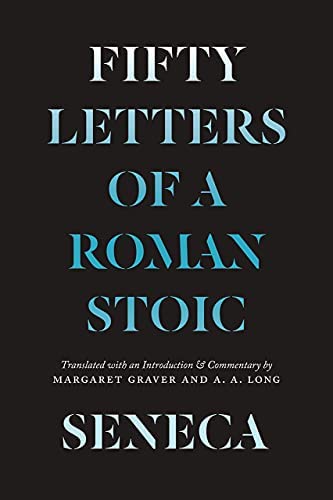
Rarely does one find a translation of ancient philosophy that is easy to read. Even more rarely does one find a translation that is both readable and enjoyable. A holy grail is that translation of classical wisdom which is simultaneously readable, fun to read, and applicable in its philosophical prescriptions. In her translation of Seneca, 50 Letters of a Roman Stoic, Aaron Lawrence Professor in Classics Margaret Graver accomplishes such a singular feat.
As a lover of the sage advice of Marcus Aurelius, I began 50 Letters with a basic understanding of stoicism and an appreciation of the intimate, confessional nature of many stoic works. For the uninitiated, stoicism as a school comprises the basic belief that man can be happy when he accepts the world as it is, swears off the mindless pursuit of pleasure and freedom from suffering, and understands that certain things reside outside of his control. Like with many ancient philosophies, any discussion of stoicism — especially when in an abbreviated form like 50 Letters — has a chance of veering off into the overly abstract.
And yet, one of the many joys of Graver’s new translation and, indeed, Seneca’s timeless wisdom is that it never gets lost in the conceptual. Each of the philosopher’s letters — addressed to his friend Lucilius — focuses on a specific topic or musing, often impelled by a recent incident in the thinker’s life. Letter 21 describes “[h]ow reading can make you famous,” while 75 speaks of “what it means to make progress.” The end effect of such topical choice by Seneca and the editorial choice of headlining each letter by subject means that 50 Letters is not only well translated but also usable by the reader.
The meat of each specific translation holds up to the high standard set by the book as a whole. The epistolary prose of Seneca, as wrought into English by Graver, is clear. Unlike the vast majority of translations I have had the misfortune of reading, I never felt confused in 50 Letters by rococo grammatical constructions comprising multiple clauses that run on with semicolon after semicolon. The average sentence in the book runs to an economical handful of lines. Even more importantly, the meaning of Seneca’s words in this translation is apparent. Graver deploys manageable, accessible word choice with not a hint of philosophical jargon, excusing a French idiom I saw in one letter. The collision of all of these choices results in a collection of philosophical wisdom that one can quote from and annotate, even from the first page.
Because Graver’s book comprises letters, each of the 50 chapters exhibits an intimacy that one cannot find in other philosophical works. Seneca wrote these epistles as guidance for and to his friends, not for mass adulation. In effect, they exude candor. Where even the most principled thinker might self-censor or wordsmith what he knows the public will see, Seneca speaks frankly about the stoic issues raised by realities such as seasickness or wealth. “I too will take twenty years to get wherever I am going if I have to get there by ship,” he writes in Letter 53. “No matter how much you own, the mere fact that someone has more will make you think that your resources are insufficient by exactly the amount that his are greater,” Seneca — who was himself wealthy — asserts in 104. It is a rare thing to hear the opinions of a Roman philosopher on an issue that affects software engineers and investment bankers today.
It is in such direct applications to modern life that 50 Letters finds its stride. Indeed, 50 Letters is the rare type of philosophy and self-help book that will probably end up bettering the lives of its readers. The messages contained within each of the 50 eponymous sections stay with you long after you turn to the next letter. In letter 12, the reader learns that “[e]very pleasure saves its greatest delights for its last moments.” Meanwhile, in Letter 74, Seneca helps define greatness: “The great man is not the one who merely commands his own death but the one who actually finds a death for himself.” In 107, the philosopher teaches us that “[i]f you value it [liberty] highly, you must devalue everything else.”
However, is 50 Letters alone enough to actually change a life? Probably not. In regards to the stoic canon, Graver’s translation has a natural sequel in the equally frank and even more pithy Meditations of Marcus Aurelius. At the same time, I stress the importance of drawing from the greater ancient and modern philosophical canon when engaging in self-development. Speaking from my own spiritual experience, I cannot recommend highly and equally enough Plato’s tetralogy The Last Days of Socrates, The Holy Bible, Hesse’s Siddhartha, and even Heinlein’s Starship Troopers. Nevertheless, 50 Letters deserves the time and attention of anyone who aspires to a liberal-arts education in the modern world. As a useful introduction to stoic philosophy, Graver’s book more than succeeds. Fundamentally, this is a rare book. Few other works can appeal simultaneously to Buddhist monks and businessmen, Green Berets and wannabe emperors just as it appealed to provincial administrators and actual emperors more than a millennium ago. This book is comparable to The Art of War in its quotability and counseling power. The translation stays true to the original purpose of stoic philosophy by helping guide readers towards lasting happiness in life. Margaret Graver’s 50 Letters of a Roman Stoic helps you, as Seneca helped his friend Lucilius, “assert your own freedom.” When encountered on Amazon or at a book store, this work is an education not to be shirked.

Be the first to comment on "Seneca in Short: Professor Margaret Graver’s 50 Letters of a Roman Stoic"